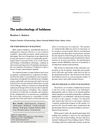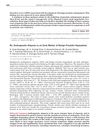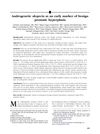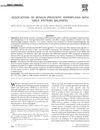TLDR The conclusion is that more hair loss (androgenetic alopecia) is linked to larger prostate size, suggesting hair loss could be an early sign of benign prostatic hyperplasia.
This document is an observational study that aimed to establish the relationship between androgenetic alopecia (AGA) and the size of the prostate. The study included 65 male patients with AGA, and it found that as the grade of AGA increased, there was an increase in the size of the prostate. The study suggests that AGA may serve as an early marker for benign prostatic hyperplasia (BPH). However, further research is needed to better understand this association and to evaluate the potential benefits of treating AGA with 5-alpha reductase inhibitors in delaying the onset of BPH.
 19 citations
,
April 2014 in “Hormones”
19 citations
,
April 2014 in “Hormones” Hormones and genetics play key roles in male and female baldness, which can affect mental health and may be linked to other health issues.
 5 citations
,
September 2012 in “The Journal of Urology”
5 citations
,
September 2012 in “The Journal of Urology” Early hair loss may indicate future prostate issues.
 28 citations
,
August 2011 in “Journal of The American Academy of Dermatology”
28 citations
,
August 2011 in “Journal of The American Academy of Dermatology” Early hair loss may indicate prostate issues.
 33 citations
,
October 2004 in “Archives of Dermatological Research”
33 citations
,
October 2004 in “Archives of Dermatological Research” Large prostate links to more hair loss, but age of onset doesn't affect it.
 21 citations
,
June 2002 in “PubMed”
21 citations
,
June 2002 in “PubMed” The conclusion is that there might be a link between certain types of baldness and prostate cancer, which could be due to shared hormonal pathways.
 54 citations
,
May 1998 in “Urology”
54 citations
,
May 1998 in “Urology” Men with enlarged prostates often have more severe baldness.
 1 citations
,
January 2019 in “PubMed”
1 citations
,
January 2019 in “PubMed” Baldness score can't be used to predict prostate size.
January 2018 in “프로그램북(구 초록집)” No link between hair loss severity and PSA levels in men.
January 2017 in “Indian journal of health sciences and biomedical research KLEU” There is no link between hair loss and prostate enlargement.
 3 citations
,
January 2015 in “DOAJ (DOAJ: Directory of Open Access Journals)”
3 citations
,
January 2015 in “DOAJ (DOAJ: Directory of Open Access Journals)” There's no link between hair loss type androgenic alopecia and benign prostatic hyperplasia, but early hair loss and family history can mean more severe alopecia.









